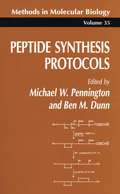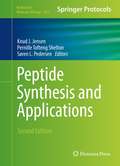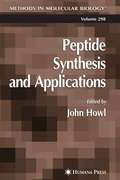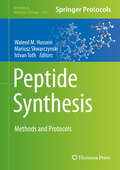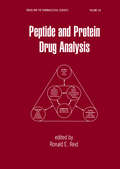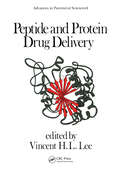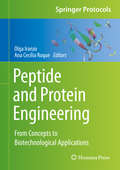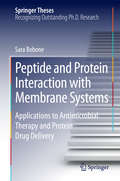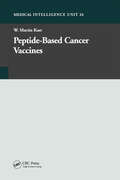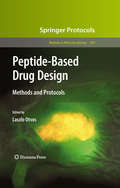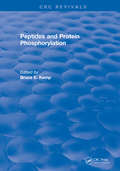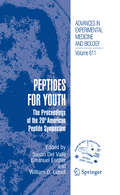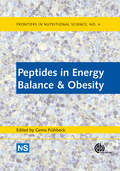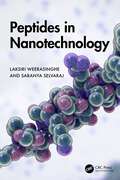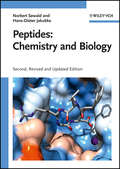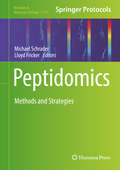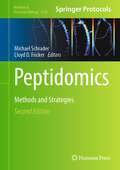- Table View
- List View
Peptide Self-Assembly and Engineering: Fundamentals, Structures, and Applications
by Xuehai YanPeptide Self-Assembly and Engineering State-of-the-art research in peptide self-assembly, with coverage of fundamental aspects of how peptides self-assemble and an extensive number of applications Peptide Self-Assembly and Engineering: Fundamentals, Structures, and Applications (2V set) covers the latest progresses in the field of peptide self-assembly and engineering, including the fundamental principles of peptide self-assembly, new theory of nucleation and growth, thermodynamics and kinetics, materials design rules, and precisely controlled structures and unique functions. The broad contents from this book enable readers to obtain a systematical and comprehensive knowledge in the field of peptide self-assembly and engineering. Contributed by the leading scientists and edited by a highly qualified academic and an authority in the field, Peptide Self-Assembly and Engineering includes information on: Emerging areas in peptide assembly, such as immune agents, bioelectronics, energy conversion, flexible sensors, biomimetic catalysis, and more Existing applications in biomedical engineering, nanotechnology, and photoelectronics, including tissue engineering, drug delivery, and biosensing devices History of peptide self-assembly for design of functional materials and peptides’ unique mechanical, optical, electronic, and biological properties Various solvent conditions, such as pH, ionic strength, and polarity, that can affect the structure and stability of peptide assemblies A very comprehensive reference covering the latest progresses in the field of peptide self-assembly and engineering, Peptide Self-Assembly and Engineering is an essential resource for all scientists performing research intersecting with the subject, including biochemists, biotechnologists, pharmaceutical chemists, protein chemists, materials scientists, and medicinal chemists.
Peptide Self-Assembly: Methods and Protocols (Methods in Molecular Biology #1777)
by Bradley L. Nilsson Todd M. DoranThis volume details methods and protocols on b-sheet assemblies and collagen. Divided into three parts chapters focus on expanding use of solid-state NMR as a powerful method to enhance structural understanding of self-assembled peptide materials, methods for the design, synthesis, and application of self-assembled peptide materials, and structural and mechanistic analyses of pathological amyloid systems that provide novel ways to assess function of the various possible aggregates as well to determine how the structure of these materials correlates to function/dysfunction in the biological context. Written in the highly successful Methods in Molecular Biology series format, chapters include introductions to their respective topics, lists of the necessary materials and reagents, step-by-step, readily reproducible laboratory protocols, and tips on troubleshooting and avoiding known pitfalls.Authoritative and cutting-edge, Peptide Self-Assembly: Methods and Protocols aims to capture modern methods that span the breadth of the exciting and expanding field of peptide self-assembly.
Peptide Synthesis Protocols
by Ben M. Dunn Michael W. PenningtonIn Peptide Synthesis Protocols leading authorities assemble in one volume a broad range of state-of-the-art methods for the preparation, purification, and synthesis of peptides. These powerful and useful protocols contain many innovations not previously described, including a compilation of chemical modification procedures and peptide synthesis improvements. The authors describe each procedure in a practical, step-by-step fashion suitable for both the skilled and novice researcher. They also provide troubleshooting tips, alternative ways of doing things, and informative explanations about why certain steps are necessary--aids not usually found in standard journal recipes--all designed to guarantee a significant difference in the outcome of your experiments. Pennington and Dunn's Peptide Synthesis Protocols offers a comprehensive collection of standardized, readily reproducible methods for many critical procedures that will enable scientists in every area of biochemical and biological research to prepare, purify, characterize, and use peptides effectively.
Peptide Synthesis and Applications
by Soren L. Pedersen A. Pernille Tofteng Knud J. JensenPeptides are used ubiquitously for studies in biology, biochemistry, chemical biology, peptide based medicinal chemistry, and many other areas of research. There is a number of marketed peptide drugs, and the prospects for the development of new peptide drugs are very encouraging. The second edition of Peptide Synthesis and Applications expands upon the previous editions with current, detailed methodologies for peptide synthesis. With new chapters on laboratory protocols for both the specialist and the non-specialist. Written in the highly successful Methods in Molecular Biology series format, chapters include introductions to their respective topics, lists of the necessary materials and reagents, step-by-step, readily reproducible laboratory protocols, and key tips on troubleshooting and avoiding known pitfalls. Authoritative and practical, Peptide Synthesis and Application, Second Edition seeks to aid scientists in understanding different approaches to the synthesis of peptides by using a broad range of methods and strategies.
Peptide Synthesis and Applications
by John HowlHands-on experts describe in step-by-step detail the key methodologies of contemporary peptide synthesis and illustrate their numerous applications. The techniques presented include protocols for chemical ligation, the synthesis of cyclic and phosphotyrosine-containing peptides, lipoamino acid- and sugar-conjugated peptides, and peptide purification and analyses. Additional chapters detail methodologies and instrumentation for high-throughput peptide synthesis, many different applications of peptides as novel research tools and biological probes, and the design and application of fluorescent substrate-based peptides that can be used to determine the selectivity and activity of peptidases. A practical guide to the identification of proteins using mass spectrometric analyses of peptide mixtures is also included.
Peptide Synthesis: Methods and Protocols (Methods in Molecular Biology #2103)
by Waleed M. Hussein Mariusz Skwarczynski Istvan TothThis book provides a variety of procedures for synthetically producing peptides and their derivatives, ensuring the kind of precision that is of paramount importance for successful synthesis. Numerous techniques relevant to drugs and vaccines are explored, such as conjugation and condensation methodologies. Written for the highly successful Methods in Molecular Biology series, chapters include introductions to their respective topics, lists of the necessary materials and reagents, step-by-step, readily reproducible laboratory protocols, and tips on troubleshooting and avoiding known pitfalls. Authoritative and practical, Peptide Synthesis: Methods and Protocols serves as an essential guide to the many crucial processes that will allow researchers to efficiently prepare, purify, characterize, and use peptides for chemical, biochemical, and biological studies.
Peptide Synthesis: Methods and Protocols (Methods in Molecular Biology #2931)
by Waleed M. Hussein Mariusz SkwarczynskiThis fully updated second edition provides a variety of procedures for synthetically producing peptides and their derivatives, ensuring the kind of precision that is important for successful synthesis. Chapters explore techniques relevant to drugs and vaccines are explored, such as conjugation and condensation methodologies. Written for the highly successful Methods in Molecular Biology series, chapters include introductions to their respective topics, lists of the necessary materials and reagents, step-by-step, readily reproducible laboratory protocols, and tips on troubleshooting and avoiding known pitfalls. Authoritative and cutting-edge, Peptide Synthesis: Methods and Protocols, Second Edition aims to be comprehensive guide for researchers in the field.
Peptide Therapeutics: Fundamentals of Design, Development, and Delivery (AAPS Advances in the Pharmaceutical Sciences Series #47)
by Seetharama D. JoisThis book explains how peptide-based drug design works, what steps are needed to develop a peptide-based therapeutic, and challenges in synthesis as well as regulatory issues. It covers the design concept of peptide therapeutics from fundamental principles using structural biology and computational approaches. The chapters are arranged in a linear fashion. A fresh graduate or a scientist who works on small molecules can use this to follow the design and development of peptide therapeutics to use as understanding the basic concepts. Each chapter is written by experts from academia as well as industry. Rather than covering extensive literature, the book provides concepts of design, synthesis, delivery, as well as regulatory affairs and manufacturing of peptides in a systematic way with examples in each case. The book can be used as a reference for a pharmaceutical or biomedical scientist or graduate student who wants to pursue their career in peptide therapeutics. Some chapters will be written as a combination of basic principles and protocol so that scientists can adopt these methods to their research work. The examples provided can be used to perform peptide formulation considerations for the designed peptides. The book has nine chapters, and each chapter can be read as an independent unit on a particular concept.
Peptide and Protein Drug Analysis
by Paul C. H. LiFurthering efforts to simulate the potency and specificity exhibited by peptides and proteins in healthy cells, this remarkable reference supplies pharmaceutical scientists with a wealth of techniques for tapping the enormous therapeutic potential of these molecules-providing a solid basis of knowledge for new drug design.Provides a broad, comp
Peptide and Protein Drug Delivery (Advances in Parenteral Science)
by Lee, Vincent H. L.This reference/text covers fundamentals of peptide and protein drug delivery, including such considerations as synthesis, physical chemistry and biochemistry, analysis, proteolytic and transport constraints, pharmacokinetics, and pharmacodynamics; bioavailability from routes of administration, detai
Peptide and Protein Engineering: From Concepts to Biotechnological Applications (Springer Protocols Handbooks)
by Olga Iranzo Ana Cecília RoqueThis thorough book aims to present the methods that have enabled the success of peptides and proteins in a wide variety of applications. It opens with a section on chemical tools applied to the production or engineering of peptides and proteins, and concludes with a collection of chapters on biological approaches used to engineer structure and function in peptides and proteins. As a book in the Springer Protocols Handbooks series, chapters include the kind of detailed descriptions and tips necessary for successful results in practice. Authoritative and practical, Peptide and Protein Engineering: From Concepts to Biotechnological Applications will be of great use to scientists in academia and industry seeking a better understanding of the emerging principles and methodologies in peptide and protein engineering.
Peptide and Protein Interaction with Membrane Systems
by Sara BoboneIn her thesis, Sara Bobone outlines spectroscopic studies of antimicrobial peptides (AMPs) which are promising lead compounds for drugs used to fight multidrug resistant bacteria. Bobone shows that AMPs interact with liposomes and she clarifies the structure of pores formed by one of these molecules. These results help us to understand how AMPs are selective for bacterial membranes and how their activity can be finely tuned by modifying their sequence. Findings which solve several conundrums debated in the literature for years. In addition, Bobone uses liposomes as nanotemplates for the photopolymerization of hydrogels - exploiting the self- assembly properties of phospholipids. Bobone was able to trap an enzyme using nanometeric particles, while still allowing its activity by the diffusion of substrates and products through the network of the polymer. The innovative nano devices described in this thesis could solve many of the hurdles still hampering the therapeutic application of protein-based drugs.
Peptide-Based Cancer Vaccines
by W. Martin KastThe field of peptide based cancer vaccines has evolved tremendously in the last decade of this century. The exploration on how to apply the peptide knowledge for vaccination purposes began when it was demonstrated that these peptides after being mixed into adjuvants actually induced T cell responses that could prevent virus infections and tumor growth in experimental animal models. The results of animal models are currently translated into clinical applications with all their associated difficulties and heterogeneity. Initial promising data do appear, warranting further research in this area. This book pays tribute to key researchers in the field.
Peptide-Based Drug Design
by Laszlo OtvosDue to their high specificity and low toxicity profile, peptides have once again become central to the development of new drugs. In Peptide-Based Drug Design: Methods and Protocols, expert researchers provide a handbook which offers a selection of research and production tools suitable for transforming a promising protein fragment or stand-alone native peptide into a pharmaceutically acceptable composition. The volume delves into contemporary, cutting-edge subjects such as hit isolation and target validation, computer-aided design, sequence modifications to satisfy pharmacologists, in vivo stability and imaging, and the actual production of difficult sequences. Written in the highly successful Methods in Molecular BiologyTM series format, chapters include readily reproducible, step-by-step laboratory protocols, lists of materials, and the Notes section, which highlights tips on troubleshooting and avoiding known pitfalls. Comprehensive and up-to-date, Peptide-Based Drug Design: Methods and Protocols shows its subject to be an independent science on the rise, and provides scientists with a clear, concise guide for continuing this vital research.
Peptide-Based Materials
by Timothy DemingSynthesis of Polypeptides by Ring-Opening Polymerization of α-Amino Acid N-Carboxyanhydrides, by Jianjun Cheng and Timothy J. Deming.- Peptide Synthesis and Self-Assembly, by S. Maude, L. R. Tai, R. P. W. Davies, B. Liu, S. A. Harris, P. J. Kocienski and A. Aggeli.- Elastomeric Polypeptides, by Mark B. van Eldijk, Christopher L. McGann, Kristi L. Kiick andJan C. M. van Hest.- Self-Assembled Polypeptide and Polypeptide Hybrid Vesicles: From Synthesis to Application, by Uh-Joo Choe, Victor Z. Sun, James-Kevin Y. Tan and Daniel T. Kamei.- Peptide-Based and Polypeptide-Based Hydrogels for Drug Delivery and Tissue Engineering, by Aysegul Altunbas and Darrin J. Pochan.-
Peptides (Neuromethods #6)
by Alan A. Boulton Glen B. Baker Q. J. PittmanThis timely new volume in Bouton and Bader's highly practical Neuromethods series presents state-of-the-art techniques for neuropeptide research. Neuromethods * 6 * Peptides highlights the vast array of novel techniques that are essential for identifying neural peptides and explaining their roles, which have become a significant focus of attention in neuropharmacology today. In addition to providing a detailed methodological formula for each technique, the authors - all renowned experts in their particular areas - also demonstrate how their powerful new methodologies contribute to our understanding of neuropeptide function. Chapters explore: * posttranslational processing, * radioimmunoassay development, * in vitro peptide release, * peptide analogs, * molluscan models, * anitbody production, * immunohistochemical localization, * peptide release in vivo, * postsynaptic sequences, * electrophysiological techniques
Peptides and Protein Phosphorylation
by B.E. KempThis comprehensive volume focuses on the ways in which synthetic peptides have been exploited in order to expand our understanding of the molecular mechanisms involved in protein phosphorylation. It recognizes that virtually all physiological processes are regulated by protein phosphorylation. It discusses the use of synthetic peptides in studying the catalytic mechanism and regulation of protein kinases. It also includes the chemical synthesis of phosphorylated peptides and preparation of specific antisera. This incredible work has lead to the development of a new generation of peptide inhibitors with potencies of greater magnitude than those previously known. Everyone involved with biochemistry and molecular biology will find this one-of-a-kind resource fascinating and filled with useful information.
Peptides for Youth
by William D. Lubell Susan Valle Emanuel EscherThe American Peptide Society (APS) provides a forum for advancing and promoting knowledge of the chemistry and biology of peptides. The approximately one thousand members of the Society come from North America and from more than thirty other countries throughout the world. Establishment of the APS was a result of the rapid worldwide growth that has occurred in peptide-related research, and of the increasing interaction of peptide scientists with virtually all fields of science. Peptides for Youth: The Proceedings of the the 20th American Peptide Symposium will highlight many of the recent developments in peptide science, with a particular emphasis on how these advances are being applied to basic problems in biology and medicine. The 20th American Peptide Symposium will take place June 26 - 30, 2007 in Montreal, Canada.
Peptides in Energy Balance and Obesity
by Gema FrühbeckObesity is one of the most relevant public health concerns today and it is now evident that body weight control is achieved through highly integrated physiological interactions like nutrient selection as well as being influenced by genetic and environmental factors. Moreover, energy balance regulation is a complex process aimed at maintaining constant energy stores. Presenting a detailed and comprehensive account of the roles of specific peptides in energy balance, food intake control and co-morbidities, this review provides a better understanding of the patho-physiology of energy balance and obesity.
Peptides in Nanotechnology
by Laksiri Weerasinghe Saranya SelvarajAmong the various nanomaterials, peptides have emerged as a promising tool due to their unique properties such as high specificity, biocompatibility, and low toxicity. This book provides a comprehensive overview of the field of peptide-based nanomaterials, from their synthesis to their applications. It covers the latest advancements in peptide nanotechnology and provides detailed insights into various aspects of peptide-based nanomaterials, including their properties, synthesis, characterization, and potential applications in various biomedical fields.Features: Provides up-to-date detailed descriptions of various peptide-based nanostructures and their formation. Covers a wide range of topics related to peptides in nanotechnology including their synthesis and characterization. Includes the latest research and developments in the field of peptides in nanotechnology. Contains recent applications in drug delivery, tissue engineering, imaging and diagnostics, and targeted cancer therapy. Reviews peptide-nanoparticle conjugates (PNCs). This book is aimed at graduate students and researchers in peptide synthesis, biomedical engineering, and drug development and delivery.
Peptides: Chemistry and Biology (Specialist Periodical Reports #Volume 44)
by Norbert Sewald Hans-Dieter JakubkeThoroughly updated, incorporating around 25 % new material, Sewald/Jakubke remains the only modern and scientifically up-to-date advanced textbook on peptide biochemistry, distilling the knowledge of hundreds of publications into a highly readable synopsis of this diverse field. The authors explain the broad fundamentals of peptide synthesis and structure, systematically addressing important families of biologically active peptides, and adopting an interdisciplinary approach that covers application areas in biotechnology, pharmaceutical science, and biomedicine. One major focus is on such "hot" research topics as pseudopeptides, peptidomimetics, and combinatorial synthesis. This new edition also features study questions for each learning unit, for easier self-study and classroom teaching.
Peptidomics
by Mikhail SolovievDespite being known and studied for years, peptides have never before attracted enough attention to necessitate the invention of the term "peptidomics" in order to specify the study of the complement of peptides from a cell, organelle, tissue or organism. In Peptidomics: Methods and Protocols, expert researchers present a comprehensive range of analytical techniques for the analysis of the peptide contents of complex biological samples with an emphasis often on higher throughput techniques, suitable for the analysis of large numbers of peptides typically present in the peptidomes. Encompassing a number of species ranging from bacteria to man, the methods presented intensively cover topics such as organism handling, tissue and organ dissection, cellular and subcellular fractionation, peptide extraction, fractionation and purification, structural characterization, molecular cloning, and sequence analysis. Written in the highly successful Methods in Molecular BiologyTM series format, chapters include introductions to their respective topics, lists of the necessary materials and reagents, step-by-step, readily reproducible laboratory protocols, and notes on troubleshooting and avoiding known pitfalls. Comprehensive and cutting-edge, Peptidomics: Methods and Protocols brings this ten year old field fully up-to-date in order to inspire novices and experts alike with the easy-to-follow practical advice needed to set up and carry out analysis of the peptide contents of complex biological samples.
Peptidomics: Methods And Strategies (Methods In Molecular Biology #1719)
by Michael Schrader Lloyd FrickerThis volume describes protocols for basic state-of-the-art approaches in the field of peptidomics. Most of these approaches are independent of the instruments used for analysis and can easily be adapted for equipment that is available in a typical proteomics facility. Chapters detail many of the basic techniques used to detect and identify peptides, methods for the relative quantitation of peptides between samples using isotopic labels or label-free approaches, and biological species as well as sample types. Written in the highly successful format of the Methods in Molecular Biology series, each chapter includes an introduction to the topic, a list of the necessary materials and reagents, reproducible step-by-step laboratory protocols, and tips on troubleshooting common problems and avoiding pitfalls.Authoritative and practical, Peptidomics: Methods and Strategies provides useful guidance for studies in the rapidly growing field of peptidomics.
Peptidomics: Methods and Strategies (Methods in Molecular Biology #2758)
by Michael Schrader Lloyd D. FrickerThis updated edition explores essential techniques and newly emerged applications used in the expanding field of peptidomics. The opening chapters describe sample preparation and basic techniques. Subsequent chapters delve into quantitative peptidomics, bioinformatics, deep learning approaches, non-human model organisms, and peptide toxins. The last section includes multiple chapters on applications of peptidomics for human clinical specimens. Written for the highly successful Methods in Molecular Biology series, chapters include overviews and introductions to their respective topics, lists of the necessary materials, reagents, and instrumentation, step-by-step and readily reproducible laboratory protocols, and tips on troubleshooting and avoiding known pitfalls. Authoritative and up-to-date, Peptidomics: Methods and Strategies, Second Edition serves as an ideal guide for state-of-the-art approaches in this vital field.
Peptidomimetics I
by William D. LubellThe series Topics in Heterocyclic Chemistry presents critical reviews on present and future trends in the research of heterocyclic compounds. Overall the scope is to cover topics dealing with all areas within heterocyclic chemistry, both experimental and theoretical, of interest to the general heterocyclic chemistry community. The series consists of topic related volumes edited by renowned editors with contributions of experts in the field. All chapters from Topics in Heterocyclic Chemistry are published Online First with an individual DOI. In references, Topics in Heterocyclic Chemistry is abbreviated as Top Heterocycl Chem and cited as a journal.


